brake fluid OLDSMOBILE SILHOUETTE 1996 Owners Manual
[x] Cancel search | Manufacturer: OLDSMOBILE, Model Year: 1996, Model line: SILHOUETTE, Model: OLDSMOBILE SILHOUETTE 1996Pages: 372, PDF Size: 19.39 MB
Page 196 of 372

If you drive regularly in steep country, or if you’re
planning
to visit there, here are some tips that can make
your trips safer and more enjoyable.
Keep your vehicle in good shape. Check all fluid
levels and also the brakes, tires, cooling system
and transaxle. These parts can work hard on
mountain roads.
Know how to go down hills. The most important
thing to
know is this: let your engine do some of the
slowing down. Shift to
a lower gear when you go
down a steep or long hill.
I
If you don’t shift down, your brakes could get so
hot that they wouldn’t work well. You would then
have poor braking or even none going down
a hill.
You could crash. Shift down to let your engine
assist your brakes on
a steep downhill slope.
‘ A CA,TIO,/:
I
Coasting downhill in NEUTRAL (N) or with the
ignition
off is dangerous. Your brakes will have to
do all the work of slowing down. They could get
so
hot that they wouldn’t work well. You would then
have poor braking or even none going down
a hill.
You could crash. Always have your engine running
and your vehicle in gear when you go downhill.
Know how to go uphill. You may want to shift down
to a lower gear. The lower gears help cool your engine
and transaxle, and you can climb the
hll better.
Stay in your own lane when driving on two-lane
roads
in hills or mountains. Don’t swing wide or cut
across
the center of the road. Drive at speeds that let
you stay
in your own lane.
As you go over the top of a hill, be alert. There could be
something in your lane, like a stalled car or an accident.
You may see highway signs on mountains that warn of
special problems. Examples are long grades, passing or
no-passing zones,
a falling rocks area or winding
roads.
Be alert to these and take appropriate action.
4-22
ProCarManuals.com
Page 211 of 372

When You Are Ready to Leave After
Parking on a Hill
1. Apply your regular brakes and hold the pedal down
while you:
Start your engine;
0 Shift into a gear; and
Release the parking brake.
2. Let up on the brake pedal.
3. Drive slowly until the trailer is clear of the chocks.
4. Stop and have someone pick up and store the chocks.
Maintenance When Trailer Towing
Your vehicle will need service more often when you’re
pulling
a trailer. See the Maintenance Schedule for more
on this. Things that are especially important
in trailer
operation are automatic transaxle fluid (don’t overfill),
engine oil, belts, cooling system and brake adjustment.
Each
of these is covered in this manual, and the Index
will help you find them quickly.
If you’re trailering, it’s
a good idea to review these sections before you start
your trip.
Check periodically to see that all hitch nuts and bolts
are tight.
4-37
ProCarManuals.com
Page 252 of 372
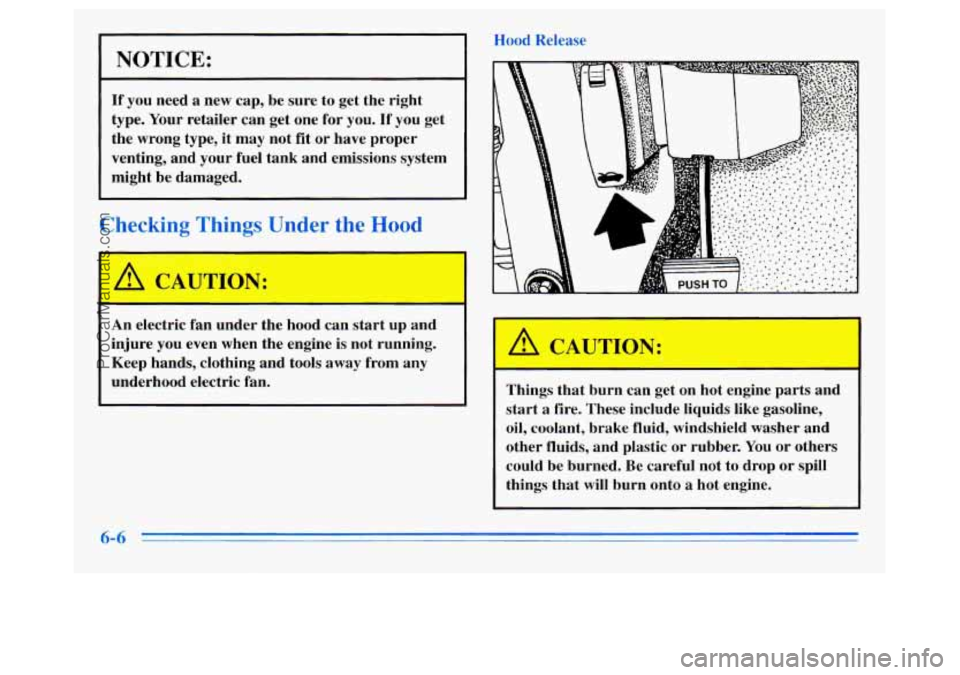
NOTICE:
If you need a new cap, be sure to get the right
type. Your retailer can get one for you.
If you get
the wrong type, it may not fit or have proper
venting, and your fuel tank and emissions system
might be damaged.
Checkhg Things Under the Hood
/I CAUTION:
An electric fan under the hood can start up and
injure you even when the engine is not running.
Keep hands, clothing and tools away from any
underhood electric fan.
Hood Release
A CAUTION:,,
I
Things that burn can get on hot engine parts and
start a fire. These include liquids like gasoline,
oil, coolant, brake fluid, windshield washer and
other fluids, and plastic or rubber. You or others
could be burned. Be careful not to drop or spill
things that will burn onto
a hot engine.
6-6
ProCarManuals.com
Page 254 of 372
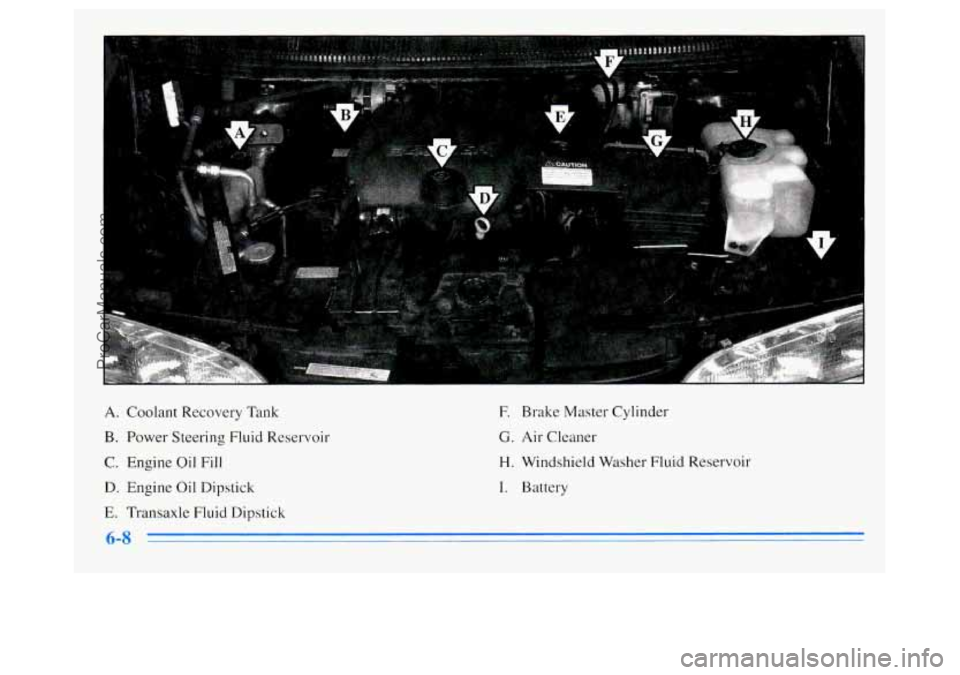
A. Coolant Recovery Tank
B. Power Steering Fluid Reservoir
C. Engine Oil Fill
D. Engine Oil Dipstick
E. Transaxle Fluid Dipstick
E Brake Master Cylinder
G. Air Cleaner
H. Windshield Washer Fluid Reservoir
I. Battery
ProCarManuals.com
Page 262 of 372

~. ~~ ~ ~~ ~- . -
How to Check
Because this operation can 'be a little difficult, you may
choose to have
this done at your Oldsmobile retail
facility Service Department.
If you do it yourself, be sure to follow all the instructions
here, or you could get a false reading on
the dipstick.
NOTICE:
Too much or too little fluid can damage your
transaxle.
Too much can mean that some of the
fluid could come out and fall
on hot engine parts
or exhaust system parts, starting a fire. Be sure to
get an accurate reading if you check your
transaxle fluid.
Wait at least 30 minutes before checking the transaxle -
fluid level if you have been driving:
0 When outside temperatures are above 90°F
At high speed for quite a while.
In heavy traffic -- especially in hot weather.
0 While pulling a trailer.
(32°C).
- ___ ~~ ~ ~_
To get the right reading, the fluid should be at normal
operating temperature,
which is 180 "F to 200 "F
(82°C to 93°C).
Get the vehicle warmed up by driving about 15 miles
(24 km) when outside temperatures are above 50°F
(10°C). If it's colder than 50°F (lO°C), you may have
to drive longer.
Checking the Fluid Level
0 Park your vehicle on a level place. Keep the engine
running.
0 With the parking brake applied, place the shift lever
in PARK (P).
0 With your foot on the brake pedal, move the shift
lever through each gear range, pausing for about
three seconds in each range. Then, position
the shift
lever in PARK
(P).
0 Let the engine run at idle for three to five minutes.
6-16
ProCarManuals.com
Page 271 of 372
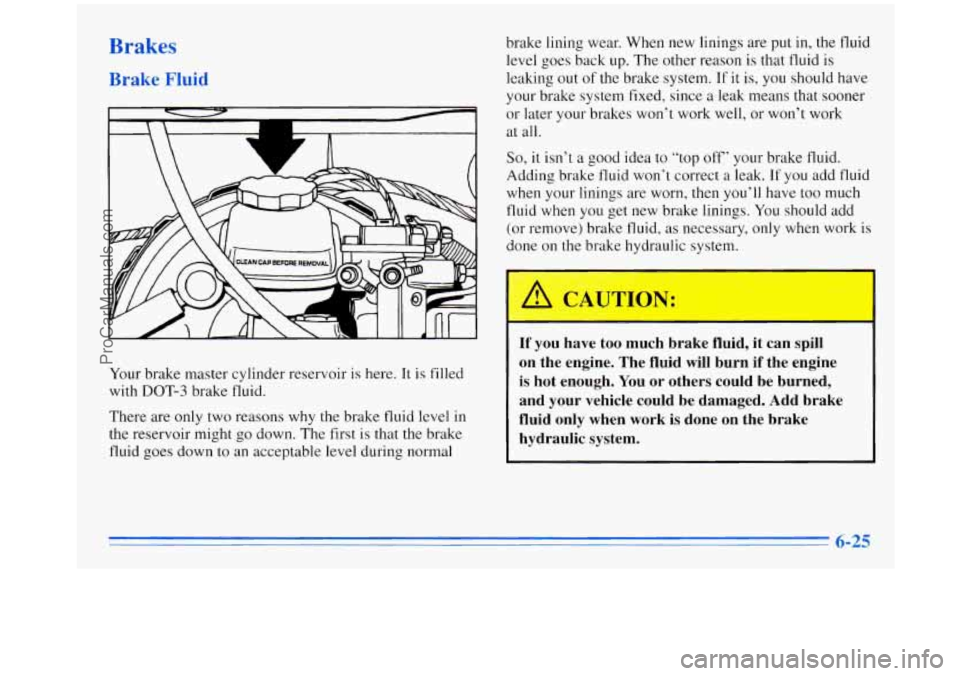
ra
rkes
IF id
rour brake master cylinder reservoir is here. It is filled
with DOT-3 brake fluid.
There are only two reasons why the brake fluid level in
the reservoir might
go down. The first is that the brake
fluid
goes down to an acceptable level during normal brake lining
wear. When new linings are put
in, the fluid
level goes back up. The other reason is that fluid is
leaking out
of the brake system. If it is, you should have
your brake system fixed, since
a leak means that sooner
or later your brakes won’t work well, or won’t work
at all.
So, it isn’t a good idea to “top off’ your brake fluid.
Adding brake fluid won’t correct
a leak. If you add fluid
when your linings are worn, then you’ll have
too much
fluid when you get new brake linings. You should add
(or remove) brake fluid,
as necessary, only when work is
done
on the brake hydraulic system.
If you have too much brake fluid, it can spill
on the engine. The fluid will burn if the engine
is hot enough. You or others could be burned,
and your vehicle could be damaged. Add brake
fluid only when work is done on the brake hydraulic system.
ProCarManuals.com
Page 272 of 372
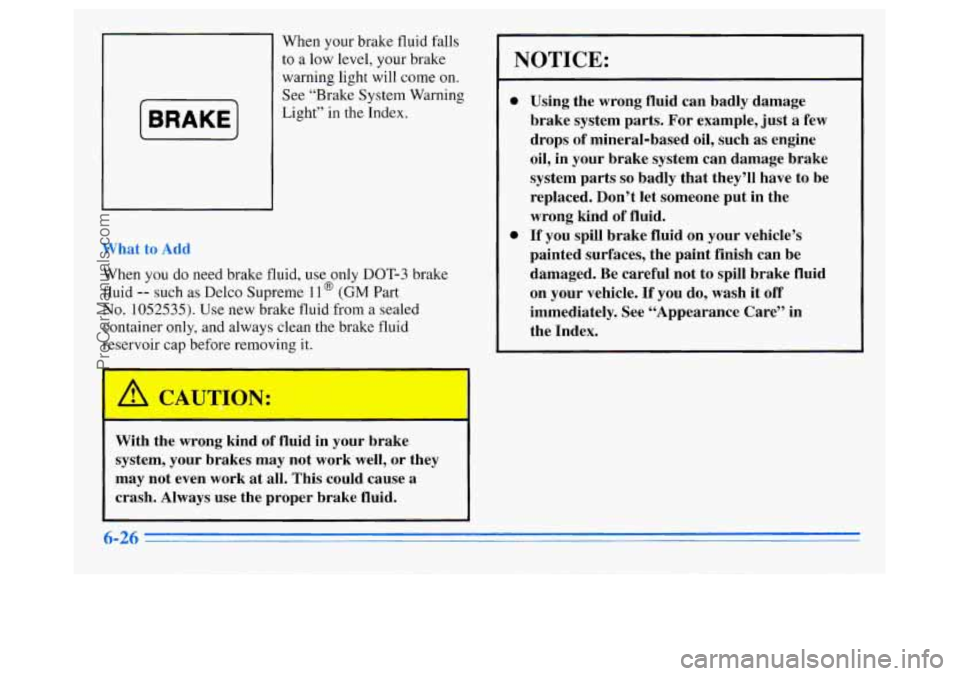
When your brake fluid falls
to
a low level, your brake
warning light
will come on.
See “Brake System Warning
I BRAKE I
What to Add
When you do need brake fluid, use only DOT-3 brake
fluid
-- such as Delco Supreme 11 @ (GM Part
No. 1052535). Use new brake fluid from a sealed
container only, and always clean the brake fluid
reservoir cap before removing
it.
r
With the wrong kind of fluid in your brake
system, your brakes may not work well, or they
may not even work
at all. This could cause a
crash. Always use the proper brake fluid.
NOTICE:
a
0
Using the wrong fluid can badly damage
brake system parts. For example, just
a few
drops of mineral-based oil, such as engine
oil, in your brake system can damage brake
system parts
so badly that they’ll have to be
replaced. Don’t let someone put in the
wrong kind of fluid.
If you spill brake fluid on your vehicle’s
painted surfaces, the paint finish can be
damaged. Be careful not to spill brake fluid
on your vehicle. If you do, wash it
off
immediately. See “Appearance Care” in
the Index.
6-26
ProCarManuals.com
Page 345 of 372

Part D: Recommended Fluids and
Lubricants
NOTE: Fluids and lubricants identified below by name,
part number or specification may be obtained from your
GM retailer.
USAGE
Engine Oil
Engine Coolant
FLUIDLUBRICANT
Engine oil with the American
Petroleum Institute Certified For
Gasoline Engines “Starburst”
symbol of the proper viscosity.
To
determine the preferred viscosity
for your vehicle’s engine, see
“Engine Oil” in the Index.
50/50 mixture of clean wateL
(preferably distilled) and GM
Goodwrench@ DEX-COOL
TM or
Havoline@ DEX-COOL’”
(orange-colored, silicate-free)
antifreeze conforming
to GM
Specification 6277M. See “Engine
Coolant” in the Index.
USAGE
Coolant
Supplement
Sealer
Hydraulic Brake
System
Parking Brake
Cable Guides
Power Steering
System
Automatic
Transaxle
Key Lock
Cylinders GM
Part No. 3634621 or
equivalent with a complete flush
and refill.
(GM Part No.
1052535 or
Chassis lubricant (GM Part
No. 1052497 or equivalent) or
lubricant meeting requirements
of NLGI Grade 2, Category LB
or GC-LB.
GM Power Steering Fluid
(GM Part
No. 1052884 - 1 pt.,
1050017
- l qt., or equivalent).
DEXRON@-I11 Automatic
Transmission Fluid.
Multi-Purpose Lubricant, Superlube@ (GM Part No. 12346241
or equivalent).
7-39
ProCarManuals.com
Page 359 of 372
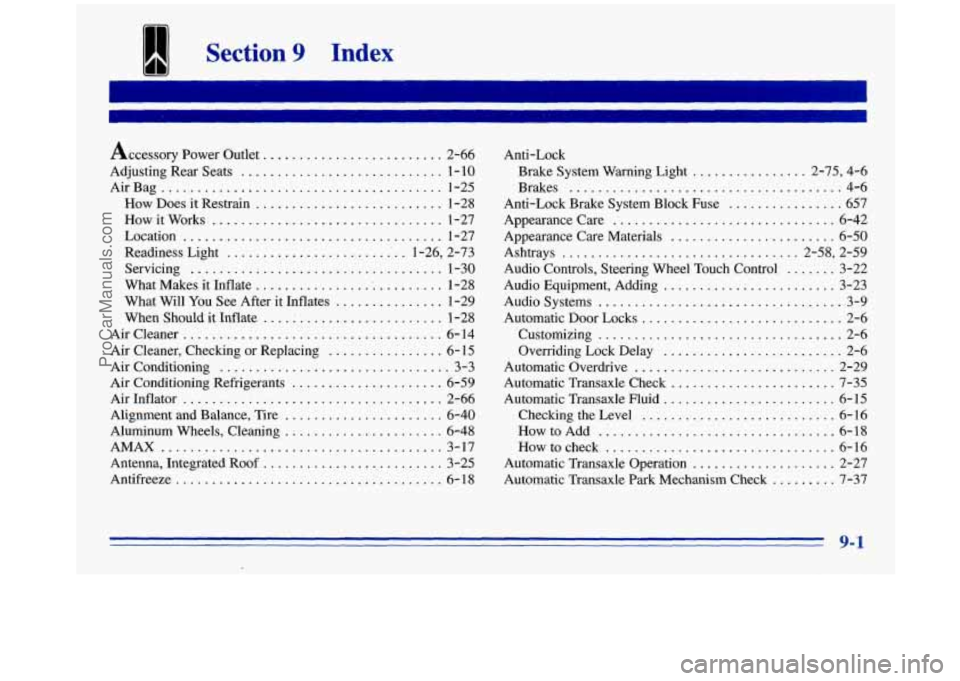
I Section 9 Index
I ..
Accessory Power Outlet ......................... 2-66
Adjusting Rear Seats
............................ 1-10
How Does it Restrain .......................... 1-28
How it Works
................................ 1-27
Location
.................................... 1-27
Readiness Light
......................... 1.26. 2.73
Servicing
................................... 1-30
What Makes it Inflate
........................... 1-28
What Will
You See After it Inflates ............... 1-29
When Should it Inflate
.... : .................... 1-28
Aircleaner
.................................... 6-14
Air Cleaner. Checking or Replacing
................ 6- 15
Air Conditioning
................................ 3-3
Air Conditioning Refrigerants
..................... 6-59
Airhflator
.................................... 2-66
Alignment and Balance. Tire
...................... 6-40
Aluminum Wheels. Cleaning
...................... 6-48
AMAX ....................................... 3-17
Antenna. Integrated Roof
......................... 3-25
Antifreeze
..................................... 6-18
AirBag
....................................... 1-25
I
.
Anti-Lock
Brake System Warning Light
................ 2.75. 4.6
Brakes
...................................... 4-6
Appearance Care
............................... 6-42
Appearance Care Materials
....................... 6-50
Ashtrays ................................. 2.58. 2.59
Audio Equipment. Adding
........................ 3-23
Audio Systems
.................................. '3-9
Automatic
Door Locks ............................ 2-6
Customizing
.................................. 2-6
Overriding Lock Delay ......................... 2-6
Automatic Overdrive
............................ 2-29
Automatic Transaxle Check
....................... 7-35
Automatic Transaxle Fluid
........................ 6-15
Checking the Level
........................... 6-16
Howtocheck
................................. 6-16
Automatic Transaxle Operation
.................... 2-27
Automatic Transaxle Park Mechanism Check
......... 7-37
Anti-Lock Brake System Block Fuse
................ 657
Audio Controls. Steering Wheel Touch Control
....... 3-22
HowtoAdd
................................. 6-18
9-1
ProCarManuals.com
Page 366 of 372
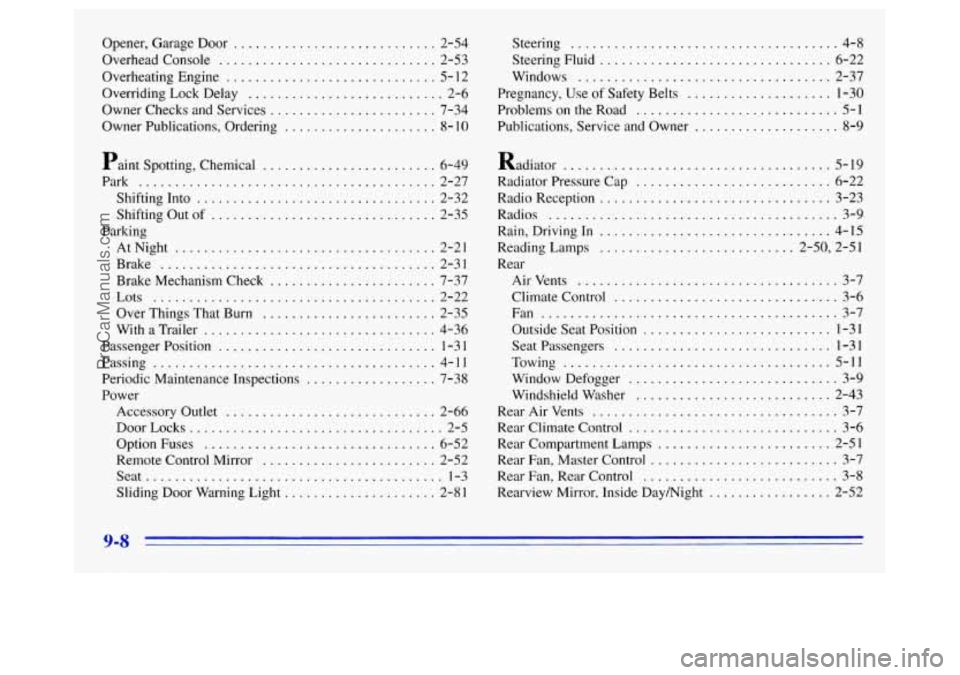
Opener. GarageDoor ............................ 2-54
Overhead Console
.............................. 2-53
Overheating Engine
............................. 5- 12
Overriding Lock Delay
........................... 2-6
Owner Checks and Services
....................... 7-34
Owner Publications. Ordering
..................... 8- 10
Paint Spotting. Chemical ........................ 6-49
Park
......................................... 2-27
Shifting Into
................................. 2-32
Shifting Out of
............................... 2-35
AtNight
.................................... 2-21
Brake
...................................... 2-31
Brake Mechanism Check
....................... 7-37
Lots
....................................... 2-22
Over Things That Burn
........................ 2-35
With
a Trailer ................................ 4-36
Passenger Position
.............................. 1-3 1
Passing ....................................... 4-11
Periodic Maintenance Inspections
.................. 7-38
Power Accessory Outlet
............................. 2-66
DoorLocks
................................... 2-5
Option Fuses
................................ 6-52
Remote Control Mirror
........................ 2-52
Seat
......................................... 1-3
Sliding Door Warning Light ..................... 2-8 1
Parking Steering
..................................... 4-8
Steering Fluid
................................ 6-22
Windows
................................... 2-37
Pregnancy. Use of Safety Belts
.................... 1-30
Problems on the Road ............................ 5-1
Publications. Service and Owner .................... 8-9
Radiator
..................................... 5-19
Radiator Pressure Cap
........................... 6-22
Radio Reception
................................ 3-23
Radios
........................................ 3-9
Reading Lamps
........................... 2-50. 2-51
Rear AirVents
.................................... 3-7
Climate Control
............................... 3-6
Rain. Driving
In
................................ 4-15
Fan
......................................... 3-7
Outside Seat Position
.......................... 1-31
Seatpassengers
.............................. 1-31
Towing
..................................... 5-11
Window Defogger
............................. 3-9
Windshield Washer
........................... 2-43
RearAirVents
.................................. 3-7
Rear Climate Control
............................. 3-6
Rear Compartment Lamps
........................ 2-51
Rear Fan. Master Control
.......................... 3-7
Rear Fan. Rear Control
........................... 3-8
Rearview Mirror. Inside Daymight
................. 2-52
9-8
ProCarManuals.com